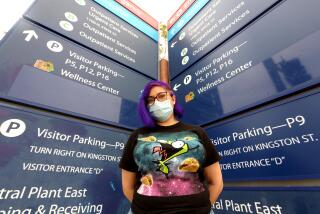
- Share via
When she found herself struggling to breathe, Yesenia Guevara tried to get medical attention at a hospital miles away from the dusty encampment under the 118 Freeway.
But Guevara and Richard Wisar, who had been with her for years in the Pacoima encampment, said they abandoned their visit after hours had passed, feeling ignored.
When things go wrong, Guevara later declared, “I’m my own doctor.”
A week after their aborted trip to the hospital, a medical team turned up outside the tent that Guevara and Wisar share, telling them there was a mobile clinic stationed a short walk away near the Ritchie Valens Recreation Center. A nurse showed people a photo on her smartphone, pointing them to a sky-blue truck the size of a semi.
“We want to be able to give you medical care right where you are,” Dr. Parham Khalili told Guevara when she and Wisar arrived at the truck.
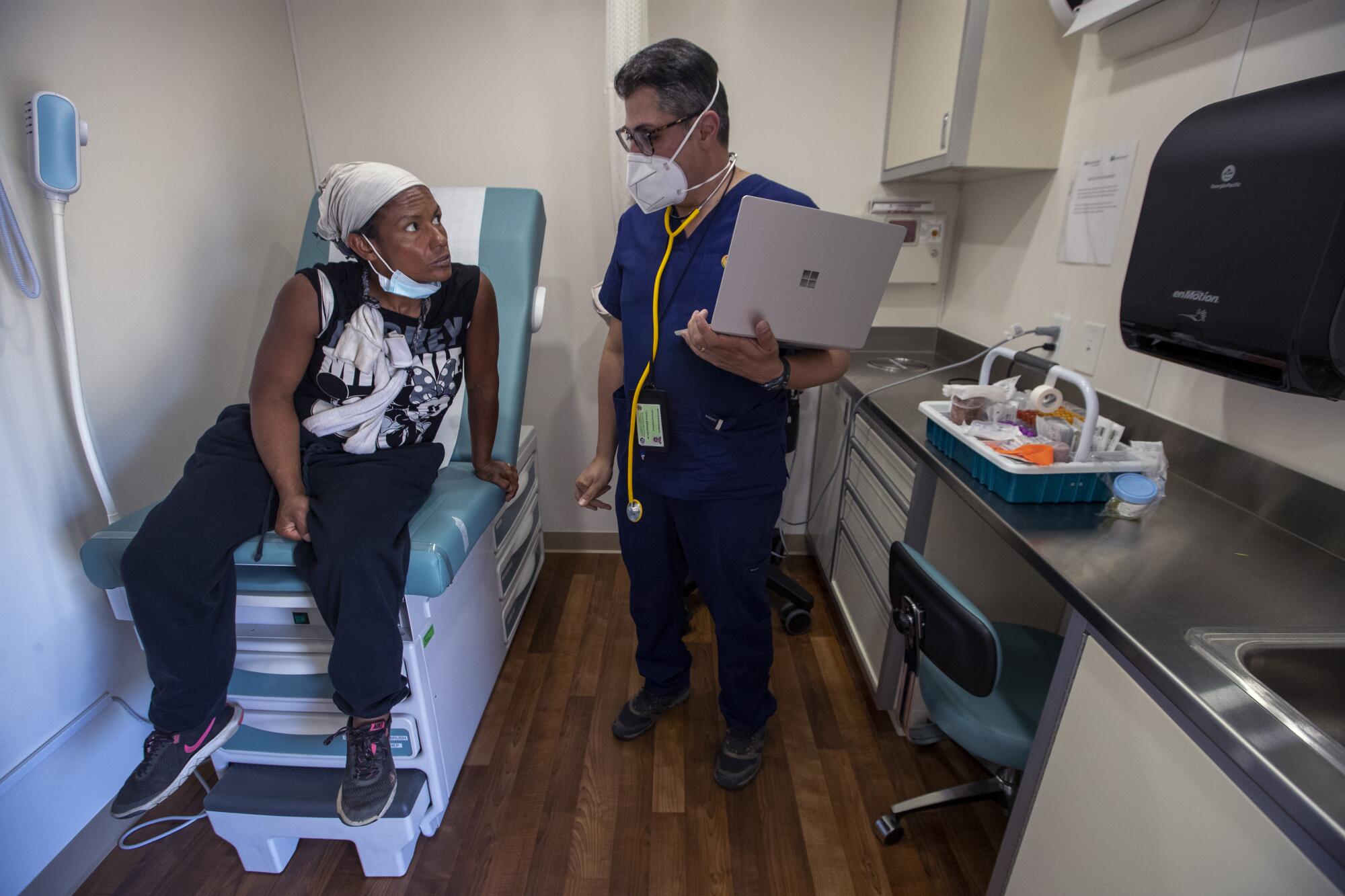
In Los Angeles County, homeless people had been suffering rising rates of mortality even before COVID-19 arrived. Deaths among unhoused people surged higher in the year after the pandemic began, and not just because of COVID-19. Public health officials found that drug overdoses were the biggest driver of the deadly increase and that other leading causes of death for unhoused people — including heart disease — also claimed more lives than before.
The pandemic had thrust the Los Angeles County Department of Health Services directly into street medicine, but the need went beyond the coronavirus, as its medical teams offering COVID-19 vaccines also tended to other maladies on the streets. In some cases, patients needed medical procedures that the street teams could not readily provide in the field.
So the Department of Health Services launched its own system of rolling clinics this fall, expanding the range of medical care that its clinicians can immediately offer to unhoused people.
The big blue trucks, each equipped with a pair of private examination rooms, boast a range of services that can be difficult or impossible to perform on a sidewalk or inside a tent.
The rolling clinics can provide primary and urgent care, including ultrasounds and electrocardiograms; psychiatric care and substance use treatment, including medications to ease addiction; and gynecological care such as Pap smears, among other services. The mobile clinics can also connect patients with social workers and financial screeners to enroll them in programs.
Beginning in September, the county has been regularly stationing the clinics at spots close to homeless encampments and short on medical services.
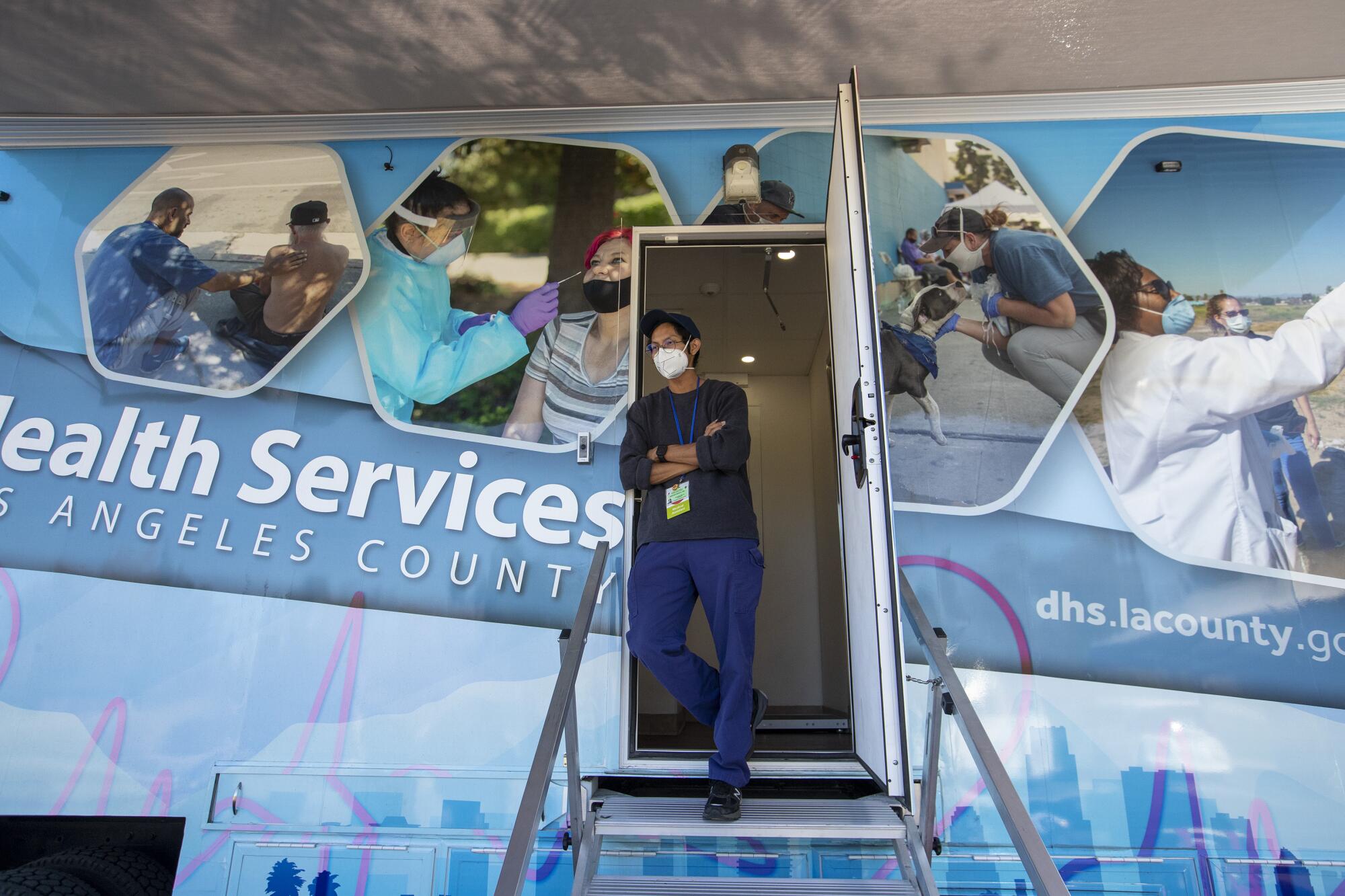
The rolling clinic allows healthcare providers to do medical procedures “that we would otherwise not be able to do in the field,” or that are safer to do in a clinic, said Dr. Absalon Galat, medical director for the mobile clinic and street medicine program at the L.A. County Department of Health Services. “We’re trying to plug in the holes of the system.”
Outside the blue truck, Guevara unspooled her medical history to a nurse. “So shortness of breath and chest pain — how long have you had that?” asked registered nurse Richelle Legaspi.
“Nine months,” Guevara, 47, replied.
Legaspi asked her about nausea and aches; alcohol and marijuana and meth; mammograms and vaccinations. At one point, Guevara told the nurse she hated needles; Legaspi assured her that they could avoid them today. When the nurse asked if she had fallen recently, Guevara nodded.
“I had to pick you up and carry you,” added Wisar, 40, who was seated next to her.
“He’s my angel,” Guevara replied, smiling, and rested her foot on his knee.
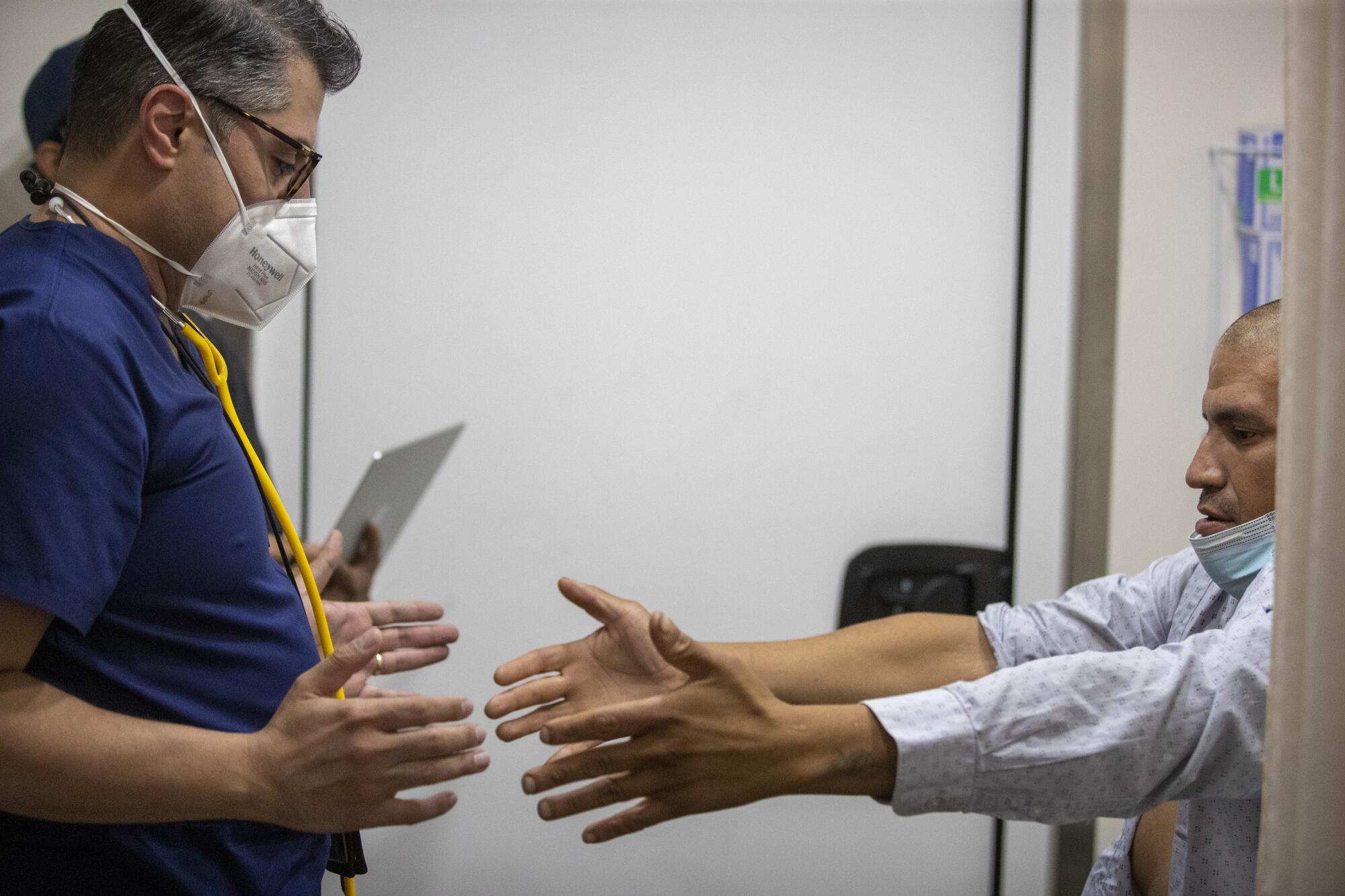
Khalili, the physician dedicated to this area of L.A. County in the mobile clinic program, proudly declared that the rolling unit was able to match or exceed the services available in brick-and-mortar clinics, not merely provide “second-tier care.” And unlike a brick-and-mortar clinic, the blue truck can move if homeless encampments relocate.
Health officials said that the mobile clinics are meant to ensure immediate access to care that homeless patients might otherwise struggle to reach. County teams found that 83% of the encampments they visited had unmet needs for primary care; nearly half were in need of urgent care; and almost a third of encampments had unmet needs for women’s healthcare.
Other services that homeless people use, such as meal programs, often demand that unhoused “people fit the schedule of others, as opposed to building a schedule that fits their needs,” said Katie League, clinical policy manager at the National Health Care for the Homeless Council. That can mean that homeless people are “making a decision between getting a meal and being in line for a walk-in appointment.”
Some unhoused patients have been reluctant to leave behind their pets or belongings to make a long trip to a medical center. League also cited the practical barriers, for many homeless patients, to getting to a clinic and the ingrained distrust of healthcare, “very often as a result of themselves or people close to them receiving poor care at some point along the way.”
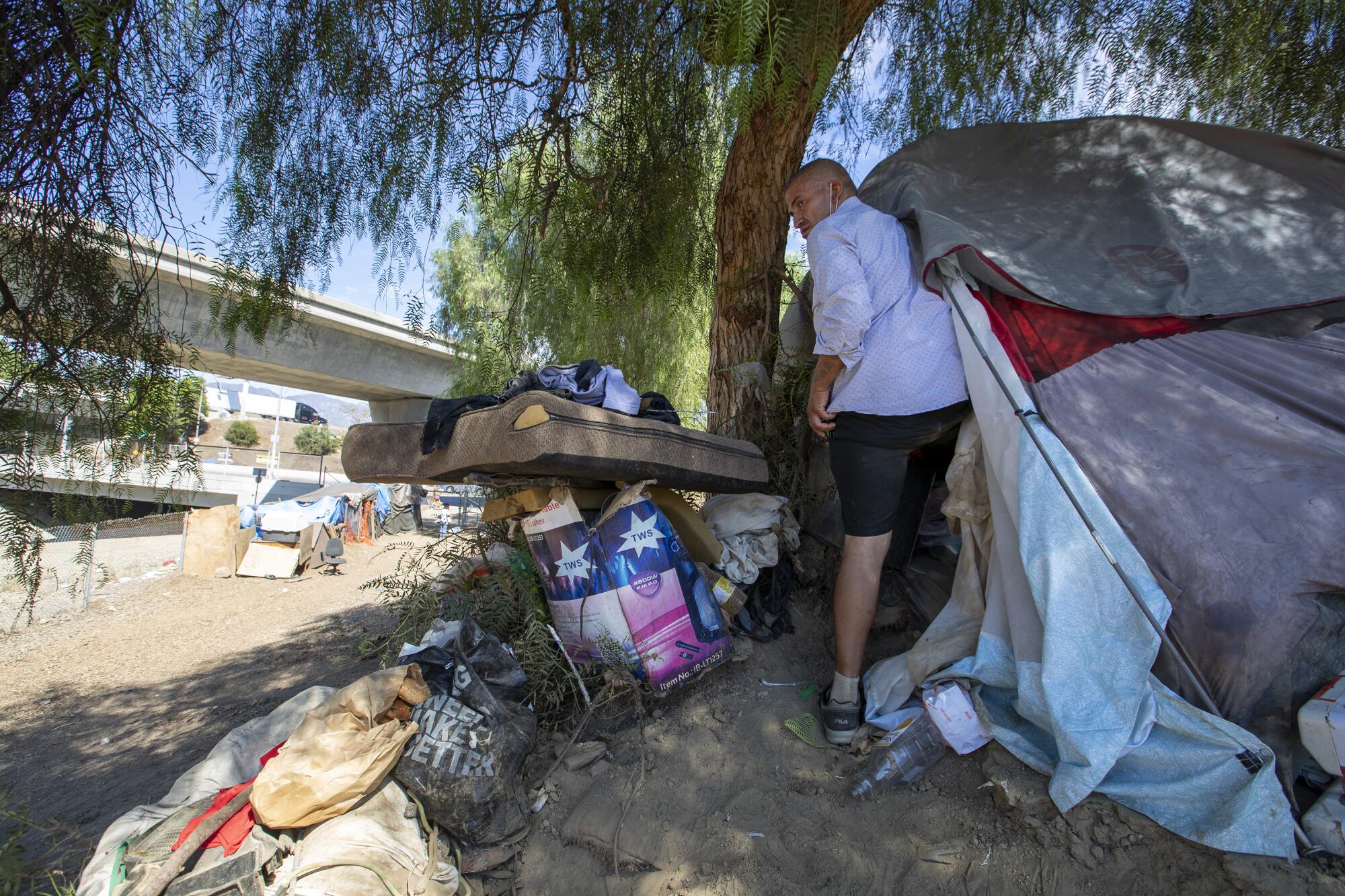
In the face of those realities, mobile units have become a growing element of caring for homeless patients in L.A. County. Saban Community Clinic launched a rolling clinic this summer. Venice Family Clinic did so last year, adding a van to its street medicine program. UCLA Health has also launched medically equipped vans to visit encampments, shelters and other sites where unhoused people are gathered, aiming to bring a range of primary, urgent and specialty care to the streets.
League called the L.A. County Department of Health Services effort “very unique” nationally. Medical vehicles of the size that L.A. County is deploying — as large as a semi — are often used for onetime events rather than consistent care, League said. Few exist nationally because of the costs and practical challenges of setting them up, she said.
What L.A. County is doing is rare in its “scale, staffing and consistency,” League said.
So far, L.A. County has four units in its new fleet, each of which will park in the same spot for roughly seven hours for each visit. The COVID-19 street teams had already helped map out encampments, giving the county a clearer picture of where they were needed.
The county spent more than $2.2 million to purchase the vehicles using federal money meant to provide relief for health providers that assisted COVID-19 patients; the day-to-day operating costs are being shouldered by the county through its general budget, although it is also seeking reimbursements from health plans.
Khalili described each mobile clinic as an “anchor,” from which medical teams in smaller vans will fan out to find patients; Galat called that work “roving rounds.”
Many kinds of medical care can and will still be provided on the streets, but patients can also be ferried back to the mobile clinics for additional help. The L.A. County Department of Health Services aims to bring the mobile clinics out to the same sites every two weeks for consistency, with smaller teams able to visit more often to follow up with patients.

When Khalili sat down with Guevara, he talked with her briefly about a medication that might help her with alcohol use, but assured her that she didn’t need to decide on anything yet, since the team hoped to see her again. “Maybe what we can do next is a little exam together,” Khalili said. “Is that OK with you?”
Guevara agreed. “We’ll just go from top to bottom,” the doctor said. With gloved fingers, he touched the sides of her throat, feeling her lymph nodes. He asked if it was OK to snake a stethoscope down the back of her shirt, to listen to her lungs. Toward the end of the exam, he paused at a mark on her leg and asked if it was from a burn. No, she said, a broken bottle.
“I know you don’t like needles,” Khalili said to Guevara at one point, but the woman interrupted, telling him she would be open to getting her blood drawn to see what was ailing her.
Inside the truck, she sat quietly and watched as her blood filled one vial and then another. Guevara said she couldn’t remember the last time her blood was drawn, but “I just want to be sure that everything is fine.” At one point, she reached out and gently brushed a loose tendril out of the face of the nurse attending her.

“I’m proud of you, Yesenia,” licensed vocational nurse Munisa Saidova told Guevara after bandaging her arm.
Khalili explained that drawing blood can be hard to do in the field, since clinicians need to make sure that blood samples are kept at the right temperature and taken to a laboratory in time. The blood samples could help the doctor check Guevara’s kidney and liver function; see if she was anemic; and detect other metabolic conditions.
As Guevara was getting her blood drawn, the doctor was in the other exam room with Wisar, asking him to lift and rotate his arms to try to suss out the source of his back pain. Khalili decided to prescribe Wisar a soothing gel, checking on the pharmacy address to be sure it was in reach for him. Many medications can be dispensed directly from the truck, including a range of antibiotics and other medicines to quash hypertension, help people struggling with alcohol or other substance use, and ease nausea and pain.
Khalili told the couple that the truck would be back in a few weeks, but that he would return sooner in a smaller vehicle to check on them. Guevara and Wisar left in the broiling sun with a bag loaded with bottles of water and Gatorade, as well as boxes of Narcan to prevent opioid overdoses in the encampment.
“Alright, doctor, take care!” Wisar called out, and they strolled back to their tent under the 118 Freeway, arm in arm.
More to Read
Sign up for Essential California
The most important California stories and recommendations in your inbox every morning.
You may occasionally receive promotional content from the Los Angeles Times.


